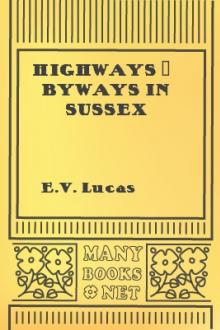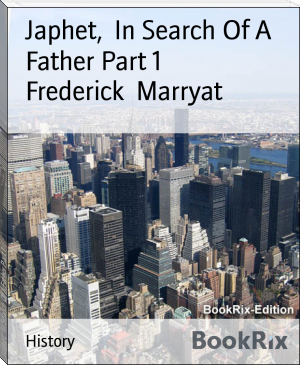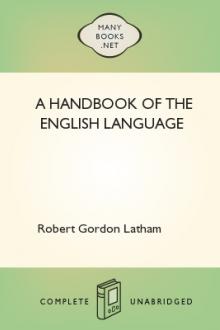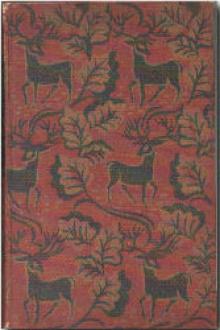Highways & Byways in Sussex by E. V. Lucas (e reader pdf best .txt) 📕

- Author: E. V. Lucas
- Performer: -
Book online «Highways & Byways in Sussex by E. V. Lucas (e reader pdf best .txt) 📕». Author E. V. Lucas
I might just mention that the little church which one sees from the Dyke railway, standing alone on the hill side, is Hangleton. Dr. Kenealy, who defended the Claimant, is buried there. The hamlet of Hangleton, which may be seen in the distance below, once possessed a hunting lodge of the Coverts of Slaugham, which, after being used as labourers' cottages, has now disappeared. The fine Tudor mansion of the Bellinghams', now transformed into a farm house, although it has been much altered, still retains many original features. In the kitchen, no doubt once the hall, on an oak screen, are carved the Commandments, followed by this ingenious motto, an exercise on the letter E:
Hangleton House
Hangleton House.From the Dyke hill one is within easy walking distance of many Wealden villages. Immediately at the north end of the Dyke itself is Poynings, with its fine grey cruciform church raising an embattled tower among the trees on its mound. It has been conjectured from the similarity of this beautiful church to that of Alfriston that they may have had the same architect. Poynings (now called Punnings) was of importance in Norman times, and was the seat of William FitzRainalt, whose descendants afterwards took the name of de Ponyngs and one of whom was ennobled as Baron de Ponyngs. In the fifteenth century the direct line was merged into that of Percy. The ruins of Ponyngs Place, the baronial mansion, are still traceable.
Following the road to the west, under the hills, we come first to Fulking (where one may drink at a fountain raised by a brewer to the glory of God and in honour of John Ruskin), then to Edburton (where the leaden font, one of three in Sussex, should be noted), then to Truleigh, all little farming hamlets shadowed by the Downs, and so to Beeding and Bramber, or, striking south, to Shoreham.
If, instead of turning into Poynings, one ascends the hill on the other side of the stream, a climb of some minutes, with a natural amphitheatre on the right, brings one to the wooded northern escarpment of Saddlescombe North Hill, or Newtimber Hill, which offers a view little inferior to that of the Dyke. At Saddlescombe, by the way, lives one of the most learned Sussex ornithologists of the day, and a writer upon the natural history of the county (so cavalierly treated in this book!), for whose quick eye and descriptive hand the readers of Blackwood have reason to be grateful. Immediately beneath Newtimber Hill lies Newtimber, consisting of a house or two, a moated grange, and a little church, which, though only a few yards from the London road, is so hidden that it might be miles from everywhere. On the grass bank of the bostel descending through the hanger to Newtimber, I counted on one spring afternoon as many as a dozen adders basking in the sun. We are here, though so near Brighton, in country where the badger is still found, while the Newtimber woods are famous among collectors of moths.
If you are for the Weald it is by this bostel that you should descend, but if still for the Downs turn to the east along the summit, and you will come to Pyecombe, a straggling village on each side of the London road just at the head of Dale Hill. Pyecombe has lost its ancient fame as the home of the best shepherds' crooks, but the Pyecombe crook for many years was unapproached. The industry has left Sussex: crooks are now made in the north of England and sold over shop counters. I say "industry" wrongly, for what was truly an industry for a Pyecombe blacksmith is a mere detail in an iron factory, since the number of shepherds does not increase and one crook will serve a lifetime and more. An old shepherd at Pyecombe, talking confidentially on the subject of crooks, complained that the new weapon as sold at Lewes, although nominally on the Pyecombe pattern, is a "numb thing." The chief reason which he gave was that the maker was out of touch with the man who was to use it. His own crook (like that of Richard Jefferies' shepherd friend) had been fashioned from the barrel of an old muzzle-loader. The present generation, he added, is forgetting how to make everything: why, he had neighbours, smart young fellows, too, who could not even make their own clothes.
Pyecombe is but a few miles from Brighton, which may easily be reached from it. A short distance south of the village is the Plough Inn, the point at which the two roads to London—that by way of Clayton Hill, Friar's Oak, Cuckfield, Balcombe and Redhill, and the other (on which we are now standing) by way of Dale Hill, Bolney, Hand Cross, Crawley and Reigate—become one.
On the way to Brighton from the Plough one passes through Patcham, a dusty village that for many years has seen too many bicycles, and now is in the way of seeing too many motor cars. In the churchyard is, or was, a tomb bearing the following inscription, which may be quoted both as a reminder of the more stirring experiences to which the Patcham people were subject a hundred years ago, and also as an example of the truth which is only half a truth:
Sacred to the memory of Daniel Scales, who was unfortunately shot on Thursday Evening, Nov. 7, 1796.
The facts of the case bear some likeness to the death of Mr. Bardell and Serjeant Buzfuz's reference to that catastrophe. Daniel Scales was a desperate smuggler who, when the fatal lead pierced him, was heavily laden with booty. He was shot through the head only as a means of preventing a similar fate befalling his slayer.
Just beyond Patcham, as we approach Brighton, is the narrow chalk lane on the left which leads to the Lady's Mile, the beginning of a superb stretch of turf around an amphitheatre in the hills by which one may gallop all the way to the Clayton mills. The grass ride extends to Lewes.
Preston, once a village with an independent life, is now Brighton; but nothing can harm its little English church, noticeable for a fresco of the murder of Thomas à Becket, a representation dating probably from the reign of Edward I.
This, however, is a digression, and we must return to Pyecombe in order to climb Wolstonbury—the most mountainous of the hills in this part, and indeed, although far from the highest, perhaps the noblest in mien of the whole range, by virtue of its isolation and its conical shape. The earthworks on Wolstonbury, although supposed to be of Celtic origin, were probably utilised by the Romans for military purposes. More than any of the Downs does Wolstonbury bring before one the Roman occupation of our country.
Immediately below Wolstonbury, on the edge of the Weald, is Danny, an Elizabethan house, to-day the seat of the Campions, but two hundred and more years ago the seat of Peter Courthope, to whom John Ray dedicated his Collection of English Words not generally used, and before then the property of Sir Simon de Pierpoint. The park is small and without deer, but the house has a façade of which one can never tire. I once saw Twelfth Night performed in its gardens, and it was difficult to believe that Shakespeare had not the spot in mind when he wrote that play.
Malthouse Farm, Hurstpierpoint
Malthouse Farm, Hurstpierpoint.The Danny drive brings us to Hurstpierpoint, or Hurst as it is generally called, which is now becoming a suburb of Brighton and thus somewhat losing its character, but which the hills will probably long keep sweet. James Hannington, Bishop of Equatorial East Africa, who was murdered by natives in 1885, was born here; here lived Richard Weeks, the antiquary; and here to-day is the home of Mr. Mitten, most learned of Sussex botanists.
To Hurst belongs one of the little Sussex squires to whose diligence as a diarist we are indebted for much entertaining knowledge of the past. Little Park, now the property of the Hannington family, where Thomas Marchant, the diarist in question, lived, and kept his journal between 1714 and 1728, is to the north of the main street, lying low. The original document I have not seen, but from passages printed by the Sussex Archæological Society I borrow a few extracts for the light they throw on old customs and social life.
"October 8th, 1714. Paid 4s. at Lewes for ¼ lb., of tea; 5d. for a quire of paper; and 6d. for two mousetraps.
"October 29th, 1714. Went to North Barnes near Homewood Gate to see the pond fisht. I bought all the fish of a foot long and upwards at 50s. per C. I am to give Mrs. Dabson 200 store fish, over and above the aforesaid bargain; but she is to send to me for them.
"October 30th, 1714. We fetched 244 Carps in three Dung Carts from a stew of Parson Citizen at Street; being brought thither last night out of the above pond.
"October 31st, 1714 (Sunday). I could not go to Church, being forced to stay at home to look after, and let down fresh water to, the fish; they being—as I supposed—sick, because they lay on the surface of the pond and were easily taken out. But towards night they sunk."
The Little Park ponds still exist, but the practice of breeding fish has passed. In Arthur Young's General View of the Agriculture of the County of Sussex, 1808, quoted elsewhere in this book, is a chapter on fish, wherein he writes: "A Mr. Fenn of London, has long rented, and is the sole monopolizer of, all the fish that are sold in Sussex. Carp is the chief stock; but tench and perch, eels and pike are raised. A stream should always flow through the pond; and a marley soil is the best. Mr. Milward has drawn carp from his marl-pits 25lb. a brace, and two inches of fat upon them, but then he feeds with pease. When the waters are drawn off and re-stocked, it is done with stores of a year old, which remain four years: the carp will then be 12 or 13 inches long, and if the water is good, 14 or 15. The usual season for drawing the water is either Autumn or Spring: the sale is regulated by measure, from the eye to the fork of the tail. At twelve inches, carp are worth 50s. and 3l. per hundred; at fifteen inches, 6l.; at eighteen inches, 8l. and 9l. A hundred stores will stock an acre; or 35 brace, 10 or 12 inches long, are fully sufficient for a breeding pond. The first year they will be three inches long; second year, seven; third year, eleven or twelve; fourth year, fourteen or fifteen. This year they breed."
Although fish-breeding is not what it was, many of the Sussex ponds are still regularly dragged, and the proceeds sold in advance to a London firm. Sometimes the purchaser wins in the gamble, sometimes the seller. The fish are removed alive, in large tanks, and sold as they are wanted, chiefly for Jewish tables. But we must return to Thomas Marchant:—
"January 16th (Sunday) 1715. I was not at church having a bad headache.
"January 25th, 1715. We had a trout for supper, two feet two inches long from eye to fork, and six inches broad;





Comments (0)